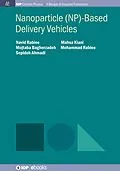Gene therapy as a potential method for the treatment of genetic disorders and other malignancies, as well as the treatment of many cancers, has attracted a great amount of attention in recent years. Current research focuses on stable and smart drug/gene-delivery systems, including controlled release. Nanoparticle (NP)-Based Delivery Vehicles looks at smart nanostructures and how these are considered a promising approach when applied to drug- and gene-delivery systems, in addition to how to solve the problems related to the inefficient transfer of medication to the affected cells.
Autorentext
Navid Rabiee graduated with MSc degree in Inorganic Chemistry from Shahid Beheshti University, Tehran, Iran, in 2018. During his MSc research, he worked on Porphyrin-based Biosensors and the application of Porphyrins and Cobalt Complexes on Dye Sensitized Solar Cells (DSSC) under the supervision of Prof. Nasser Safari. At the same time, he was focused on Drug Delivery Systems based on biocompatible and biodegradable polymers associated with different types of the sensitizers, especially porphyrins, under the supervision of Prof. Mohammad Rabiee at Amirkabir University of Technology, Tehran, Iran. In 2017, he joined ANNRG to collaborate with Prof. Mahdi Karimi's Research lab in Iran University of Medical Science, Tehran, Iran, in association with Prof. Michael R. Hamblin from Harvard Medical University, Boston, MA, working on smart microcarriers/nanocarriers applied in therapeutic agent delivery systems employed for diagnosis and therapy of various disease and disorders such as different cancers and malignancies, inflammations, infections, etc. His work has resulted in publication of over 16 peer-reviewed journal articles, 2 books and 3 conference papers.
Klappentext
Gene therapy as a potential method for treatment of genetic disorders and other malignancies as well as treatment of many cancers has attracted a great amount of attention in recent years.
Current research focuses on stable and smart drug/gene delivery systems, including controlled release. Smart nanostructures have been considered as a promising approach when applied to drug and gene delivery systems, and could solve the problems related to the inefficient transfer of medication to the affected cells.
Inhalt
- Preface
- Acknowledgements
- Author biographies
- An introduction to drug/gene delivery systems
- Smart nanostructures
- Aptamer-based nanostructures
- Protein-based nanostructures I
- Protein-based nanostructures II
- Protein-based nanostructures III
- Smart drug/gene delivery systems: toward the future
